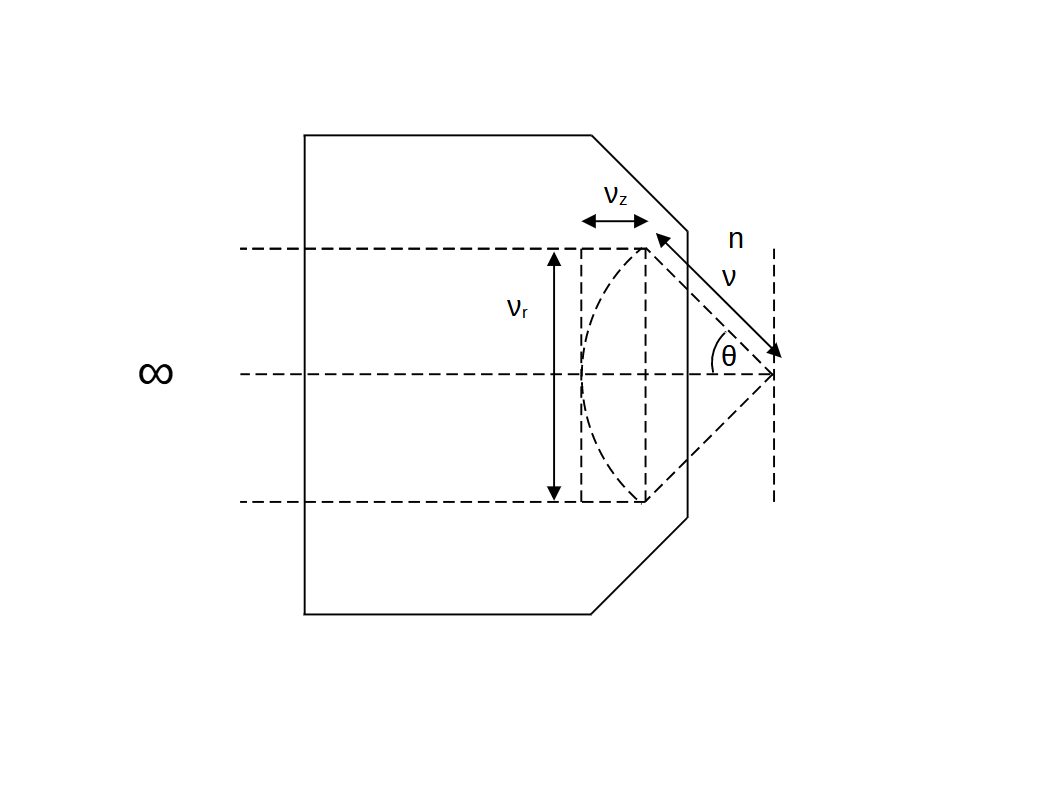Microscope objectives
An introduction to 'infinity' corrected microscope objectives.
ContentsBand limit
Inspired by McCutchen 1964, if we assume the highest spatial frequency \(\nu\) of an object that we can measure is the inverse of its emission wavelength \(\lambda\), then we can write: \[ \nu = \frac{1}{\lambda} \tag{1}\] or, \[ \nu = \frac{n}{\lambda_0} \tag{2}\] where \(\lambda_0\) is the vacuum wavelength and \(n\) is the refractive index of the medium. Here \(\nu\) is collected (or delivered) over the full angular range of the objective (twice the half angle \(\theta \)).
If we now accept that the back focal plane of an objective resides in reciprocal space (i.e. the fourier transform of the object) and that (due to the infinity correction) the back focal plane of the objective has the shape of a spherical cap, we can see from the diagram below that: \[ \nu_t = 2 \nu\sin\theta \tag{3}\] and, \[ \nu_z = \nu (1 - \cos\theta) \tag{4}\] where \(\nu_t\) and \(\nu_z\) are the highest spatial frequencies we can measure in the transverse and axial directions respectively, i.e. they are the band limit.
Note: A way to understand the origin or meaning of \(\nu_t \) is to consider plane waves. If \(\theta = 0^{\circ} \) we have only plane waves normal to the object plane and therefore no resolving power (i.e. \(\nu_t = 0 \)). If \(\theta = 90^{\circ} \) then we have counter propagating plane waves with twice the resolving power of a single wave (via wave superposition) and so \(\nu_t = 2\nu \). The intermediate case where \( 0^{\circ} \lt \theta \lt 90^{\circ} \) is relevant to a practical objective lens design (i.e. equation \((3) \)).

We can now return to real space by rewriting (3) and (4) in terms of the minimum feature size \(r_{min} = \frac{1}{\nu_t} \) and \(z_{min} = \frac{1}{\nu_z} \): \[ r_{min} = \frac{\lambda_0}{2 n \sin\theta} \tag{5}\] and, \[ z_{min} = \frac{\lambda_0}{n(1 - \cos\theta)} \tag{6}\] Equation (5) is immediately recognizable as the Abbe diffraction limit for a microscope, which we can rewrite in terms of the numerical aperture as: \[ r_{min} = \frac{\lambda_0}{2 NA} \tag{7}\] We can also convert equation (6) to a more familiar form by first rewriting in terms of \(\sin\theta\): \[ z_{min} = \frac{\lambda_0}{n(1 - (1 - \sin^2\theta)^\frac{1}{2})} \tag{8}\] and then using the Taylor expansion of the form: \[ (1 - \sin^2\theta)^\frac{1}{2} = 1 - \frac{1}{2} \sin^2\theta \; - \; ... \tag{9}\] So to 2nd order: \[ z_{min} \approx \frac{\lambda_0}{n (\frac{1}{2} \sin^2\theta)} \tag{10}\] Or in terms of numerical aperture: \[ z_{min} \approx \frac{2n\lambda_0}{NA^2} \tag{11}\] which is twice the traditional depth of field: \[ z_{min} \approx 2 DOF \tag{12}\]